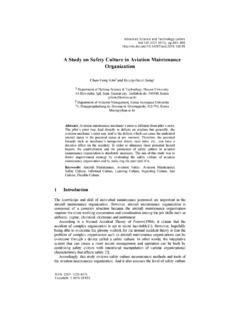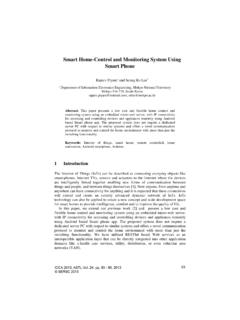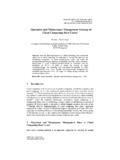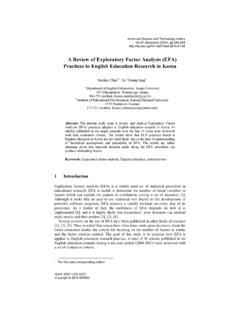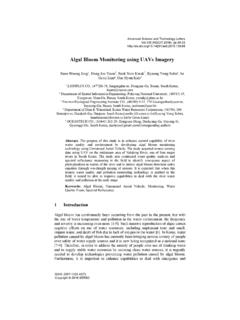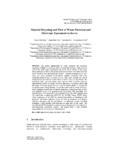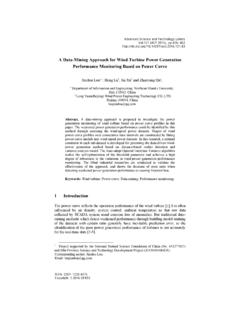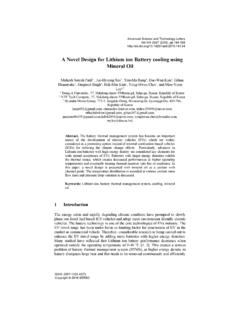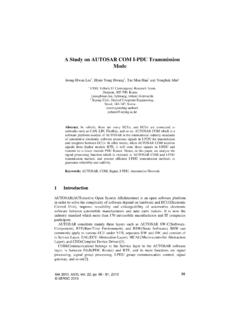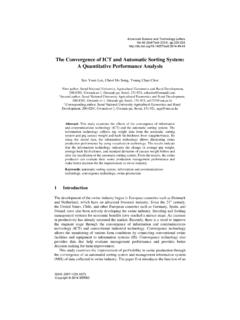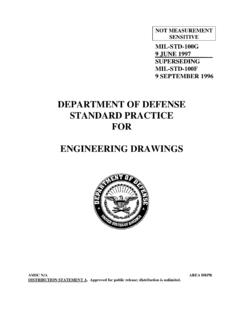Transcription of Visual Interface Factor Research for Robot Design
1 Advanced Science and Technology Letters (AST 2018), Visual Interface Factor Research for Robot Design Seung Eun Chung1 and Han Young Ryoo1,*. 1 Dept. of Content Convergence, Ewha Womans University, 52, Ewhayeodae-gil, Seodaemun-gu, Seoul 03760 Republic of Korea. {ilovechse, Abstract. In this Research , the Design factors of the Robot 's Visual Interface and the level values were to be established through reference studies and case analysis. The Visual Interface factors were composed of the GUI screen, facial expressions, and lights and the standards of the detailed level values are as follows; the GUI screen was categorized according to the physical relationship between the Robot 's appearance and the arrangement of the screen. The Robot 's facial expressions were divided into the screen type and the mechanical type and they were again grouped with similar reproduction methods.}
2 Keywords: Service Robot , Robot Design , Visual Interface Factor 1 Introduction With the rise of the social service Robot , for effective communication between the human and the Robot , the HRI (Human- Robot Interaction) researches regarding the techniques of designing the Robot Interface are actively being developed in various academic areas. The Robot 's Interface Design Factor is the whole structure that the user encounters and all the other factors are included that can express the Robot 's feelings and attitudes differently through the Design . These factors can be divided into the appearance area and the interaction area which also can be grouped into the Visual Interface , the aural Interface and the behavioral Interface . In this Research , the sub- factors of the social Robot 's Visual interfaces have been established and the detailed level values have been classified for systematization.
3 Through the reference studies and case study analysis, the key Design factors and the level values of the service Robot Interface are to be established. 2 Consideration on the Preceding Researches on the Robot Visual Interface Design Factor Among many Visual interfaces, interacting by lights has been being studied as an important Interface in the existing home appliances. Lights have been utilized a lot * Corresponding Author ISSN: 2287-1233 ASTL. Copyright 2018 SERSC. Advanced Science and Technology Letters (AST 2018). with the emotional usability and there are researches going on these days regarding the possibility of the functional usability to express the status information [1]. In the Research on the detail attributes of the light, Lee et al., [2] had conducted a study to suggest the methods of designs about the Robot products' status expression methods through a survey to verify the users' perspectives on the combinations of the flicker time, the speed, and the flow state of the light.
4 Kim et al., [3] had studied on the colors and the flickering cycle of the light to see if they could raise the basic six emotions (anger, sadness, hatred, surprise, happiness, fear). Kim et al., [4] had analyzed the combination of the color of the light and the ratio of the usage. Within the social Robot , the face Interface delivers the emotions and has an important role in communications. There are several researches that had grafted with the study results of the human's emotions in the human psychology and the animal biology studies. Bennett & abanovi [5] had studied on the range of human's understanding of the Robot 's seven facial expressions. The main Visual Interface among the existing digital media is the Graphic User Interface (GUI) and it has been a popular subject to delve into; not only there are many explanations about the factors of the graphic, the fonts, and the layouts, but also there are a lot of studies on the information designs.
5 In the robots that are recently produced use other Interface factors as well and these factors have a tendency to be utilized as a screen to convey contents services in detail or to control the Robot . 3 Design Case Analysis with Different Types of Visual Interface The Visual Interface factors have been analyzed with the total of 119 cases of the service Robot designs. In the Visual Interface , the factors have been divided into the GUI screen, the facial expression, and the light. As one of the traditional Interface factors, the GUI screen is an Interface on which the user exchanges the information through graphics. The percentage of the robots that provided the GUI screen (72%) was significantly higher than the ones did not. Some offered the GUI screen not within the Robot itself but on an external device through synchronizing the Interface with other devices such as a smart phone, etc.
6 (35%,), and some were built in the Robot itself (32%) to show the Robot 's face or messages. Moreover, the screen that is built separately from the Robot 's body but works as one (5%) appears more and more in the market and this type of screen can be physically assembled to the Robot or separated if desired. The facial expression factors are the features that reveal the Robot 's conditions or feelings through the facial factors such as the eyes, the nose, the mouth or other factors that could associate these with. Some robots did not have facial factors but in general, there were more robots that had the facial expression factors (73%). In some cases, the Robot 's face worked as the screen or the screen was provided in a physical form and depending on the level of reproduction, realistic, characterized and symbolized expressions could be observed.
7 The majority was the characterized types (23%) with the eyes, the nose, and the mouth to physically illustrate cute or interesting images and the robots without a partial Factor like a nose or mouth were frequently seen. There were also many physically symbolized type robots (15%). Copyright 2018 SERSC 175. Advanced Science and Technology Letters (AST 2018). where the geometrically simplified shapes were used or the eyes were replaced with the eyes of the helmet. When the face of the Robot is built as the screen, many symbolized types (16%) were found as emoticons or symbolized shapes were used a lot to express feelings these days. Besides, several cases without a nose or mouth were observed when the screen was provided in the characterized types (13%). On the other hand, with the realistic types, either the screen forms (2%) or the physical forms (4%) were hardly seen.
8 Lights are the Interface Factor that interacts using the Visual wavelength released from the Robot 's appearance. There were more cases found that used the light Interface (67%) than the ones that did not. When the light Factor was used in the head part (43%), it indicated mostly the facial expression factors such as the eyes, the mouth and the ears. The light was radiated if the function was in use; for example, the light was emitted from the ear when listening and from the mouth when speaking. When the light Factor was used in the torso part (57%), in many cases, the light was radiated when the sensitivity was in use as well as when the arms, etc. were moving. To consider the Design of the Robot , sometimes the light was located on the edge of the torso in the designer's point of view.
9 When it comes to the number of colors used, when a single color or similar colors were used (48%), the Robot delivered various functions or feelings by adjusting the shape or speed of the light. When a number of colors were used, on the other hand (53%), the different colors indicated different functions or feelings. In miscellaneous cases, the aesthetic was expressed using the gradation of various colors. 4 Conclusion In the Robot 's Visual Interface Design factors, the GUI screen, the facial expression, and the light, the following level values have been defined through the categorization of the references and case analysis. Firstly, the GUI screen has been categorized according to the arrangement of the screen and the Robot 's appearance. Secondly, the Robot 's facial expression has been divided into the screen type and the mechanical type and the different methods of reproduction for each type have been classified.
10 Thirdly, the light is a property of the Visual wavelength from the Robot 's appearance and it has been categorized according to the location and the color of the light. In the location Factor , the types have been classified by the Robot 's joints while they have been grouped according to the number of colors in the color Factor . The interdisciplinary consideration and trend investigation about the Factor classification in the Robot Interface Design field is essential especially as the need of the standardization of the Robot Design base study is increasing at the moment. The systematization of the Robot Interface Design factors and their level values will be used as the Design library at the industry site as well as the base study to be utilized in the future researches of the academic field.
